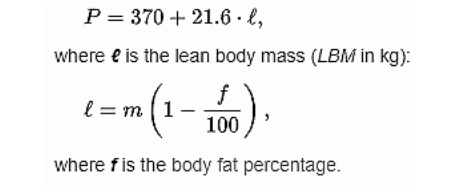Basal Metabolic Rate – How to estimate and how to use it
Basal Metabolic Rate, or BMR for short, is the term used for the rate of energy expenditure per unit time by endothermic animals (including humans) at rest. In practical terms, metabolism consists of the processes that the body needs to function, such as breathing, blood circulation, controlling body temperature, cell growth, nerve and brain function, and contraction of muscles. BMR affects the rate that a person burns calories and ultimately whether that individual maintains, gains or loses weight.
Several mathematical expressions have been published in the last couple of centuries to estimate BMR, here are the most important ones (for each of the following formulas, P is the BMR – kcal/day at complete rest; m is mass – kg, h is height – cm, a is age – years):
- Harris-Benedict equation (revised 1984): originally published in 1919, this is probably the most notable formula for estimating BMR.

- The Mifflin St Jeor equation: originally published by Mifflin et al. in 1990, considered a bit more precise than Harris-Benedict, although it only takes into account total body mass.

- The Katch–McArdle formula (for resting daily energy expenditure): together with the Cunningham formula, these are the most precise for estimating BMR, as they take into account the percentage of body fat.

These 3 are the most commonly used equations for estimating BMR available right now. If you search for BMR calculators online, they’ll most likely be using the Harris-Benedict formula, as this is the oldest and more famous method, although not the most accurate.
The BMR, being the rate at rest, usually accounts for about 55 to 65% of the total daily caloric expenditure of an individual, with 25-35% coming from physical activity and the remaining 5-10% from digestion. It is influenced by many other factors, such as volume and intensity of physical activities throughout the day, type of labor performed, macronutrients distribution per meal, etc. serving primarily as an estimate. BMR usually declines 1-2% per decade after age 20, mostly due to loss of fat-free mass and decrease in hormone levels.
Knowing your BMR is especially useful in bodybuilding as it provides a very good starting point for calculating any diet, whether it’s for gaining or losing weight. A proper macronutrient distribution per meal can be achieved once you know how much energy your body will spend to maintain it’s current weight. If the goal is to lose fat, a small caloric deficit will take place; if the goal is to build muscle, the contrary will be true, and a surplus must be achieved. A good starting strategy many people like to use is to apply a 300 or 500kcal delta (plus or minus), with the values being reassessed every two weeks to account for weight variation, training, hormonal and other adaptations that occur.









